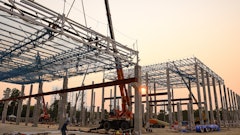
It is critical for contractors to understand the insurance requirements in construction contracts, as these projects carry very high levels of liability and risk. Construction involves moving variables, dangerous environments and hazardous conditions that can generate serious losses. Risks include fires, trench collapses, accidents and even loss of life.
Insurance is essential to protect the property owner, the business, the contractors, the employees and the public. Without proper coverage, losses may remain uninsured. A destroyed building may never be rebuilt, and an injured worker or third party may never be compensated. State, federal, and local laws require significant levels of insurance, as do the financing organizations that back these projects. If a catastrophic accident occurs, it must be an insured loss to ensure recovery.
Real-World Consequences
There are many real-world examples of how misunderstandings can create problems.
A contractor may bid on a project near navigable waters without realizing it requires U.S. Longshore and Harbor Workers’ Compensation coverage (USL&H). Later, an audit reveals the exposure, and insurance costs rise dramatically, wiping out profit.
Another example is pollution coverage. A contractor may complete substantial work but find payment withheld until pollution insurance is in place, sometimes even retroactive to the start of the job. In such cases, invoices worth millions can remain unpaid while the contractor faces uninsured exposure.
Contractors also run into problems with exclusions. In New York especially, insurers frequently impose designated work exclusions. A contractor might bid on a job without realizing their policy excludes that specific work. The result: purchasing all-new insurance at double, triple or even quadruple the expected cost.
Specialized Insurance Coverage
Typical contract requirements include General Liability, Workers’ Compensation, and Professional Liability[CS1] . But many projects go further depending on project type, specifications and location. These additional requirements often catch contractors by surprise.
- Higher Liability Limits: High-rise projects often require higher liability limits, sometimes starting at 10–15 stories, compared to the limits most contractors assume are sufficient.
- Pollution Liability: Expensive but unavoidable when dealing with contaminated soil or hazardous materials. However, this coverage should always be maintained.
- Railroad Protective Coverage: Required for work within 50 feet of railroad tracks, often a costly addition.
- U.S. Longshore and Harbor Workers’ Compensation (USL&H): Mandatory for projects within statutory distance of navigable waters. Overlooking it can lead to audits and retroactive charges.
- Horizontal Exhaustion Structures: Some contracts require liability limits to be structured in specific ways, forcing contractors with a $1–2 million program to move to a 2/4/4 limit or to secure buffer layers.
Each of these specialized requirements can significantly increase operational expenses. Contractors who do not account for them when bidding risk turning profitable projects into financial losses.
The Cost of Getting It Wrong
These requirements have a direct impact on a contractor’s cost structure. Misunderstandings often lead to hidden costs that wipe out profit. A contractor may assume their existing coverage is sufficient, only to discover exclusions or missing endorsements. That forces them to purchase new insurance mid-project, sometimes at double or triple the anticipated cost.
The average Insurance expenses can rise from 2 percent of construction value to as high as 15 percent depending on project type and risk, transforming a profitable project into a financial loss. The consequences of failing to meet contractual requirements include payment delays, suspended projects, and in some cases, losing the contract entirely.
Insurance Language: A Foreign Vocabulary
As with any industry, construction has its own vocabulary, and this extends to construction insurance, which can be confusing. There is always a great deal of “legalese” in any construction contract. Terms such as “primary and non-contributory” or “project aggregate” are often misunderstood, leading to costly mistakes.
Beyond coverage limits, contractors must also deal with complex legal language around other matters that can carry insurance implications. Contractors may find themselves in legal or financial jeopardy without a full understanding of their responsibilities.
Some common language to look for as well as terms and endorsements to understand are:
- Indemnity
- Mediation and arbitration (which are not the same thing)
- Subcontractors
- Additional insureds
- Performance guarantees (Also known as Performance Bonds)
- Force majeure
- The jurisdiction’s governing law
- Express and/or implied warranties
- Differing site conditions and how to handle them
The examples below define two of those terms, indemnity and performance guarantees, in more detail to help contractors understand their significance as they relate to both the contract and the project itself.
1. What does indemnity mean and why is it important to understand
- Indemnification in a construction contract refers to a contractual obligation where one party agrees to compensate or protect the other party against certain damages, losses or liabilities arising from specific events or circumstances related to the project. Essentially, it involves one party agreeing to hold the other harmless from legal claims or damages that may occur over the course of the work.
- Indemnification can significantly impact a contractor’s financial and legal responsibilities. If the contractor agrees to broad indemnification clauses, they may be liable for damages or claims that are not directly their fault, which could lead to substantial financial burden or legal exposure. Conversely, understanding the scope of indemnity helps the contractor assess risks and negotiate more balanced terms.
- If the contractor signs the contract without fully understanding the indemnification terms, they could be agreeing to assume liabilities beyond their control or capacity, potentially exposing their business to unexpected financial loss or legal challenges. Therefore, comprehending this clause allows the contractor to evaluate the risks accurately and seek modifications if necessary to limit their exposure.
2. Understanding and evaluating a performance guarantee and why it is so important that the contractor who signs such a contract fully understands that it requires them to provide such an instrument.
- A performance guarantee (also known as performance bond) is a financial instrument issued by a bank or insurance company on behalf of a contractor to ensure the completion of a project according to the terms and conditions specified in a contract. It acts as a security for the project owner, assuring that the contractor will fulfill their contractual obligations, and it promotes responsible project execution and protects the interests of both parties.
- Importance for a contractor:
- Financial security: It clarifies the contractor’s obligations and the financial commitment involved, ensuring they understand the extent of their liability if they fail to deliver the project as agreed.
- Risk management: Knowing what the performance guarantee covers helps contractors manage risks effectively, such as penalties, damages, or hiring alternative contractors.
- Contractual compliance: It emphasizes the importance of adhering to contract requirements, as failure to do so can result in financial penalties or loss of reputation.
- Legal implications: Understanding the terms helps avoid legal disputes over the scope, validity, and enforcement of the bond.
- Importance for a contractor:
Best Practices
The best practice is to have both a qualified construction attorney and an experienced insurance broker review every contract together. They can align contractual obligations with the contractor’s existing insurance program and identify gaps before work begins.
Failing to secure the right endorsements or meet additional insured requirements can put entire projects at risk. In extreme cases, contractors may lose contracts they were relying on to build their business if proper coverage cannot be obtained.
Contractors should take the following steps to avoid exposure:
- Review every contract carefully.
- Do not assume existing coverage will meet requirements.
- Plan for specialized coverage such as pollution, USL&H or railroad protective policies.
- Build higher liability limits into bids when necessary.
- Confirm that “additional insured” obligations can be met.
- Work with both an attorney and an insurance broker before signing.
- Resolve gaps up front to avoid payment delays or suspensions.
By following these practices, contractors can bid more accurately, avoid costly surprises and protect their long-term business interests.
The Bottom Line
Understanding insurance requirements allows contractors to present more accurate bids, start projects on time, and get paid without interruption. It also protects them from massive exposure in today’s litigious environment.
The right coverage with the right carrier and the right defense capabilities ensures that in the event of catastrophic loss, the contractor has both financial protection and strong representation.
Ultimately, having the correct insurance program in place enables contractors to reduce risk, control costs and protect the long-term future of their company.


















